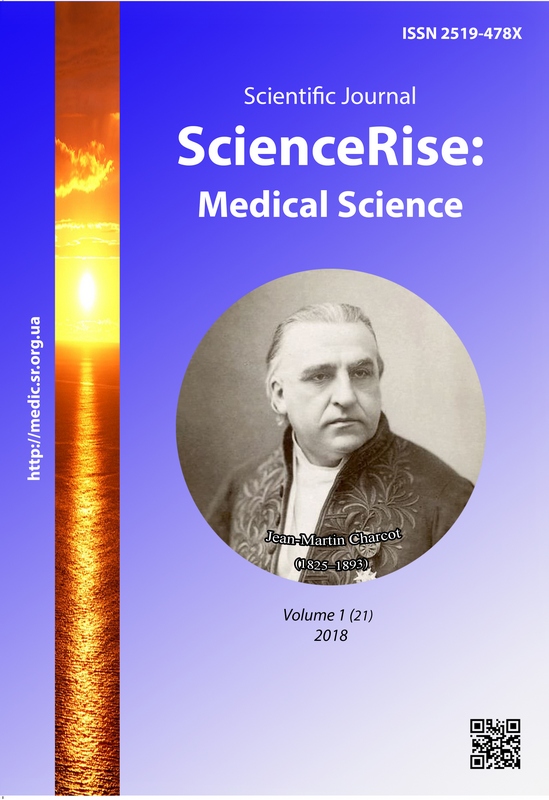Clinical phenomenology of suicidal behavior in dementia of various types
DOI:
https://doi.org/10.15587/2519-4798.2018.121956Keywords:
clinical phenomenology, suicidal behavior, thoughts, Alzheimer's disease, vascular, mixed dementiaAbstract
Aim. The study of clinical phenomenology of suicidal behavior in patients with different types of dementia aimed at defining the predictors and preventing the development of suicidal behavior within the above-mentioned category of patients.
Materials and methods. Based on the clinical and anamnestic examination of 213 patients, we studied clinical phenomenology of suicidal behavior in dementia of various types. 75 patients with Alzheimer's disease, 73 patients with vascular dementia and 60 patients with mixed dementia were examined. The main group consisted of patients with suicidal risk, the control group included patients without manifestations of suicidal behavior.
Results. Thus, in case of Alzheimer's disease anti-vital utterances (41 %) and thoughts (50 %) prevailed. Vascular dementia was characterized by outward behavioral manifestations of suicidal behavior (suicidal intentions (25.6 %), suicidal attempts (33.33 %) and anti-vital utterances (35.9 %). Patients with mixed dementia in 50 % of cases had suicidal intentions and in 66.7 % suicidal thoughts.
The most typical suicidal attempt for the patients with vascular dementia was suicide by hanging (p≤0.05), and for the patients with mixed dementia a fall under moving transport prevailed (p≤0.05).
Conclusions. There has been determined the relationship between mild dementia and the ideational component of suicidal behavior (thoughts, mood) as well as between mild dementia and outward behavioral manifestations (attempts, intentions and utterances). The presence of an additional depressive syndrome in dementia correlates with suicidal thoughts and mood; and a hallucinatory syndrome along with mixed symptomatology is connected with suicidal attempts and intentions
References
- Levin, O. S. (2010) Diagnostika i lecheniye dementsii v klinicheskoy praktike [Diagnosis and treatment of dementia in clinical practice]. Moscow: Medpress, 256.
- Adaptovana klinichna nastanova, zasnovana na dokazakh «Dementsiia» (2016). Reiestr medyko-tekhnolohichnykh dokumentiv Ministerstva okhorony zdorovia Ukrainy. Available at: http://mtd.dec.gov.ua/images/dodatki/2016_736_Demencia/2016_736_AKN_Dem.pdf
- Nock, M. K., Borges, G., Bromet, E. J., Cha, C. B., Kessler, R. C., Lee, S. (2008). Suicide and Suicidal Behavior. Epidemiologic Reviews, 30 (1), 133–154. doi: 10.1093/epirev/mxn002
- Suicide prevention (SUPRE) (2007). World Health Organization. Geneva. Available at: http://www.who.int/mental_health/prevention/suicide/suicideprevent/en/
- Szanto, K., Dombrovski, A. Y., Sahakian, B. J., Mulsant, B. H., Houck, P. R., Reynolds, C. F., Clark, L. (2012). Social Emotion Recognition, Social Functioning, and Attempted Suicide in Late-Life Depression. The American Journal of Geriatric Psychiatry, 20 (3), 257–265. doi: 10.1097/jgp.0b013e31820eea0c
- Mann, J. J. (2003). Neurobiology of suicidal behaviour. Nature Reviews Neuroscience, 4 (10), 819–828. doi: 10.1038/nrn1220
- Mudrenko, I. H. (2017). Chynnyky suyitsydal'noyi povedinky u khvorykh z dementsiyamy [Factors of suicidal behavior in patients with dementia]. Medychna psykholohiya, 3 (47), 53–57.
- Mudrenko, I. H. (2017). Farmakolohichna korektsiya depresyvnykh symptomiv u khvorykh z riznymy klinichnymy variantamy dementsiy [Pharmacological correction of depressive symptoms in patients with different clinical variants of dementia]. Ukrayinsʹkyi visnyk psykhonevrolohiyi, 25 (3 (92)), 49–54.
- Mudrenko, I. H. (2017). Efektyvnist' kohnifenu u khvorykh zriznymy klinichnymy variantamy dementsiy [The efficacy of cognifen in the treatment of dementia]. Psikhiatriya, psikhoterapiya i klinicheskaya psikhologiya, 8 (1 (12)), 409–421.
- Mudrenko, I. G. (2016). Aktual'nost' problemy suitsidal'nogo povedeniya u patsiyentov s dementsiyey [The relevance of problems of suicidal behavior in patients with dementia]. Arhiv psihiatrii, 22 (2 (85)), 112–113.
- Maruta, N., Mudrenko, I. (2017). Predictors of a suicidal behavior in patients with dementia. 25 th European congress of psychiatry. European Psychiatry, 41, 365–404. doi: 10.1016/j.eurpsy.2017.02.463
- Maruta, N. O., Yavdak, I. Ya., Cherednyakova, O. S. (2011). Osoblyvosti potrebovo-emotsiynoyi sfery u khvorykh pokhyloho viku na tryvozhno-depresyvni rozlady z suyitsydal'nym ryzykom [Especially the demand-emotion spheres in the wickedness of the abducted Wiki on the tribe-depressive plantations with the suicidal rhyme]. Ukrayins'kyi visnyk psykhonevrolohiyi, 19 (3 (68)), 50–53.
- Erlangsen, A., Zarit, S. H., Conwell, Y. (2008). Hospital-Diagnosed Dementia and Suicide: A Longitudinal Study Using Prospective, Nationwide Register Data. American Journal of Geriatric Psychiatry, 16 (3), 220–228. doi: 10.1097/jgp.0b013e3181602a12
- Purandare, N., Voshaar, R. C. O., Rodway, C., Bickley, H., Burns, A., Kapur, N. (2009). Suicide in dementia: 9-year national clinical survey in England and Wales. British Journal of Psychiatry, 194 (2), 175–180. doi: 10.1192/bjp.bp.108.050500
- Draper, B., Peisah, C., Snowdon, J., Brodaty, H. (2010). Early dementia diagnosis and the risk of suicide and euthanasia. Alzheimer’s & Dementia, 6 (1), 75–82. doi: 10.1016/j.jalz.2009.04.1229
- Haw, C., Harwood, D., Hawton, K. (2009). Dementia and suicidal behavior: a review of the literature. International Psychogeriatrics, 21 (3), 440–453. doi: 10.1017/s1041610209009065
Downloads
Published
How to Cite
Issue
Section
License
Copyright (c) 2018 Irina Mudrenko

This work is licensed under a Creative Commons Attribution 4.0 International License.
Our journal abides by the Creative Commons CC BY copyright rights and permissions for open access journals.
Authors, who are published in this journal, agree to the following conditions:
1. The authors reserve the right to authorship of the work and pass the first publication right of this work to the journal under the terms of a Creative Commons CC BY, which allows others to freely distribute the published research with the obligatory reference to the authors of the original work and the first publication of the work in this journal.
2. The authors have the right to conclude separate supplement agreements that relate to non-exclusive work distribution in the form in which it has been published by the journal (for example, to upload the work to the online storage of the journal or publish it as part of a monograph), provided that the reference to the first publication of the work in this journal is included.









